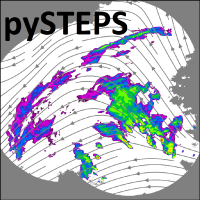pysteps.motion.darts.DARTS
pysteps.motion.darts.DARTS#
- pysteps.motion.darts.DARTS(input_images, **kwargs)#
Compute the advection field from a sequence of input images by using the DARTS method. [RCW11]
- Parameters
input_images (array-like) – Array of shape (T,m,n) containing a sequence of T two-dimensional input images of shape (m,n).
N_x (int) – Number of DFT coefficients to use for the input images, x-axis (default=50).
N_y (int) – Number of DFT coefficients to use for the input images, y-axis (default=50).
N_t (int) – Number of DFT coefficients to use for the input images, time axis (default=4). N_t must be strictly smaller than T.
M_x (int) – Number of DFT coefficients to compute for the output advection field, x-axis (default=2).
M_y (int) – Number of DFT coefficients to compute for the output advection field, y-axis (default=2).
fft_method (str) – A string defining the FFT method to use, see utils.fft.get_method. Defaults to ‘numpy’.
output_type ({"spatial", "spectral"}) – The type of the output: “spatial”=apply the inverse FFT to obtain the spatial representation of the advection field, “spectral”=return the (truncated) DFT representation.
n_threads (int) – Number of threads to use for the FFT computation. Applicable if fft_method is ‘pyfftw’.
verbose (bool) – If True, print information messages.
lsq_method ({1, 2}) – The method to use for solving the linear equations in the least squares sense: 1=numpy.linalg.lstsq, 2=explicit computation of the Moore-Penrose pseudoinverse and SVD.
verbose – if set to True, it prints information about the program
- Returns
out – Three-dimensional array (2,m,n) containing the dense x- and y-components of the motion field in units of pixels / timestep as given by the input array R.
- Return type
ndarray
